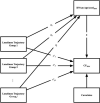Associations Between Longitudinal Loneliness, DNA Methylation Age Acceleration, and Cognitive Functioning
- PMID: 37718577
- PMCID: PMC10699733
- DOI: 10.1093/geronb/gbad128
Associations Between Longitudinal Loneliness, DNA Methylation Age Acceleration, and Cognitive Functioning
Abstract
Objectives: Loneliness may influence aging biomarkers related to cognitive functioning, for example, through accelerated DNA methylation (DNAm) aging.
Methods: In the present study, we tested whether six common DNAm age acceleration measures mediated the effects of baseline loneliness and five different longitudinal loneliness trajectories on general cognitive ability, immediate memory recall, delayed memory recall, and processing speed in 1,814 older adults in the Health and Retirement Study.
Results: We found that baseline loneliness and individuals who belong to the highest loneliness trajectories had poorer general cognitive ability and memory scores. Only DNAm age acceleration measures that index physiological comorbidities, unhealthy lifestyle factors (e.g., smoking), and mortality risk-mediated effects of baseline loneliness on general cognitive ability and memory functioning but not processing speed. These same DNAm measures mediated effects of the moderate-but-declining loneliness trajectory on cognitive functioning. Additionally, immediate and delayed memory scores were mediated by GrimAge Accel in the lowest and two highest loneliness trajectory groups. Total and mediated effects of loneliness on cognitive functioning outcomes were mainly accounted for by demographic, social, psychological, and physiological covariates, most notably self-rated health, depressive symptomatology, objective social isolation, and body mass index.
Discussion: Current findings suggest that DNAm biomarkers of aging, particularly GrimAge Accel, have promise for explaining the prospective association between loneliness and cognitive functioning outcomes.
Keywords: Cognition; DNA methylation; Epigenetic age; Loneliness; Longitudinal.
© The Author(s) 2023. Published by Oxford University Press on behalf of The Gerontological Society of America. All rights reserved. For permissions, please e-mail: journals.permissions@oup.com.
Conflict of interest statement
None declared.
Figures

Similar articles
-
Social isolation and loneliness: relationships with cognitive function during 4 years of follow-up in the English Longitudinal Study of Ageing.Psychosom Med. 2013 Feb;75(2):161-70. doi: 10.1097/PSY.0b013e31827f09cd. Epub 2013 Jan 29. Psychosom Med. 2013. PMID: 23362501
-
DNA methylation aging signatures of multiple metals exposure and their mediation effects in metal-associated mortality: Evidence from the Dongfeng-Tongji cohort study.J Hazard Mater. 2024 Mar 5;465:133200. doi: 10.1016/j.jhazmat.2023.133200. Epub 2023 Dec 10. J Hazard Mater. 2024. PMID: 38113735
-
Epigenetic Aging Biomarkers Associated With Cognitive Impairment in Older African American Adults With Human Immunodeficiency Virus (HIV).Clin Infect Dis. 2021 Dec 6;73(11):1982-1991. doi: 10.1093/cid/ciab563. Clin Infect Dis. 2021. PMID: 34143869 Free PMC article.
-
The role of adolescent lifestyle habits in biological aging: A prospective twin study.Elife. 2022 Nov 8;11:e80729. doi: 10.7554/eLife.80729. Elife. 2022. PMID: 36345722 Free PMC article.
-
How does loneliness "get under the skin" to become biologically embedded?Biodemography Soc Biol. 2023 Oct-Dec;68(4):115-148. doi: 10.1080/19485565.2023.2260742. Epub 2023 Nov 27. Biodemography Soc Biol. 2023. PMID: 37800557 Free PMC article. Review.
Cited by
-
Associations of subjective age trajectories with loneliness and stress across adulthood.PLoS One. 2025 Apr 1;20(4):e0320673. doi: 10.1371/journal.pone.0320673. eCollection 2025. PLoS One. 2025. PMID: 40168344 Free PMC article.
-
Associations Between Loneliness, Epigenetic Aging, and Multimorbidity Through Older Adulthood.J Gerontol B Psychol Sci Soc Sci. 2024 Dec 1;79(12):gbae169. doi: 10.1093/geronb/gbae169. J Gerontol B Psychol Sci Soc Sci. 2024. PMID: 39417537
-
Epigenome-wide association study of loneliness in a sample of U.S. middle-aged twins.Epigenetics. 2024 Dec;19(1):2427999. doi: 10.1080/15592294.2024.2427999. Epub 2024 Dec 8. Epigenetics. 2024. PMID: 39648520 Free PMC article.
-
Loneliness, epigenetic age acceleration, and chronic health conditions.Psychol Aging. 2024 Jun;39(4):337-349. doi: 10.1037/pag0000822. Epub 2024 Apr 18. Psychol Aging. 2024. PMID: 38635160 Free PMC article.
-
Editorial: International perspectives on older adult social isolation and loneliness.Front Public Health. 2025 Apr 8;13:1590229. doi: 10.3389/fpubh.2025.1590229. eCollection 2025. Front Public Health. 2025. PMID: 40265059 Free PMC article. No abstract available.
References
-
- Adam, E. K., Hawkley, L. C., Kudielka, B. M., & Cacioppo, J. T. (2006). Day-to-day dynamics of experience—Cortisol associations in a population-based sample of older adults. Proceedings of the National Academy of Sciences of the United States of America, 103(45), 17058–17063. 10.1073/pnas.0605053103 - DOI - PMC - PubMed
-
- Akhter-Khan, S. C., Tao, Q., Ang, T., Itchapurapu, I. S., Alosco, M. L., Mez, J., Piers, R. J., Steffens, D. C., Au, R., & Qiu, W. Q. (2021). Associations of loneliness with risk of Alzheimer’s disease dementia in the Framingham Heart Study. Alzheimer’s & Dementia, 17(10), 1619–1627. 10.1002/alz.12327 - DOI - PMC - PubMed
Publication types
MeSH terms
Substances
Grants and funding
LinkOut - more resources
Full Text Sources

